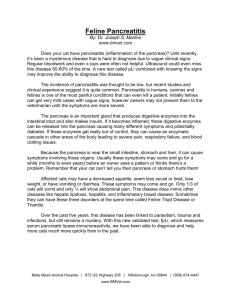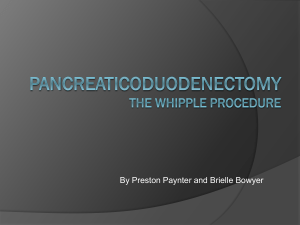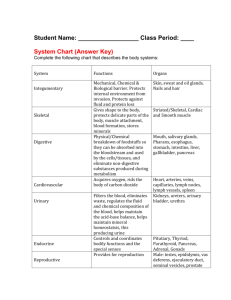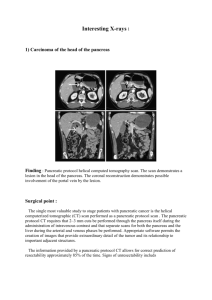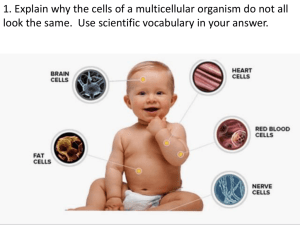Quiz-Answers-Pancreas
advertisement
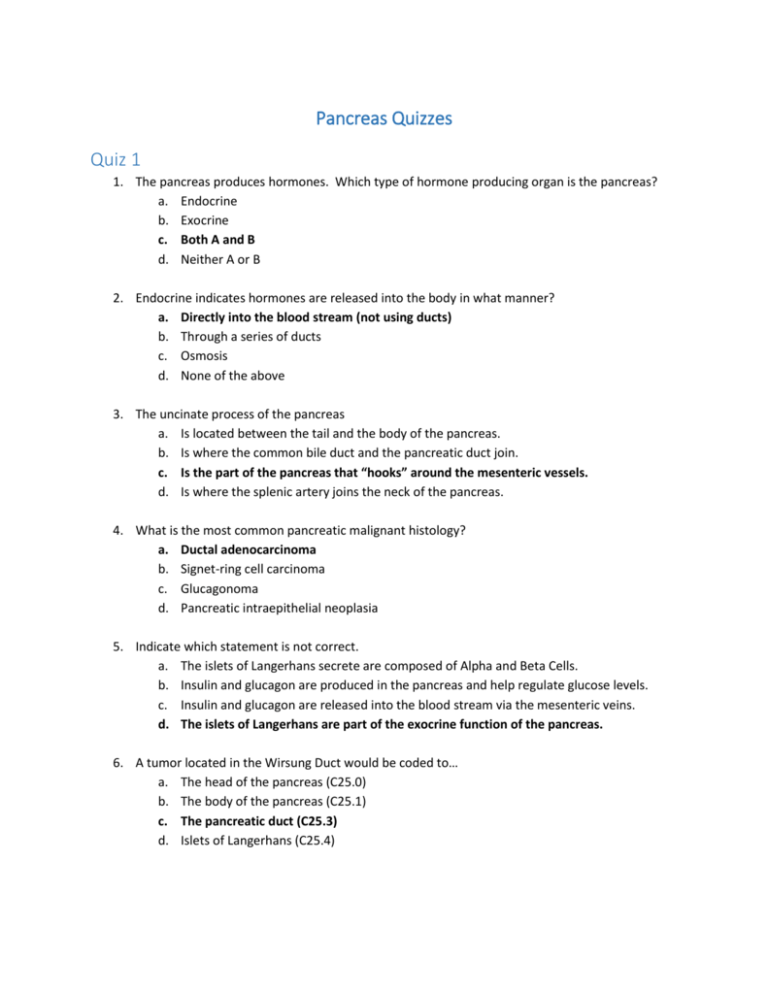
Pancreas Quizzes Quiz 1 1. The pancreas produces hormones. Which type of hormone producing organ is the pancreas? a. Endocrine b. Exocrine c. Both A and B d. Neither A or B 2. Endocrine indicates hormones are released into the body in what manner? a. Directly into the blood stream (not using ducts) b. Through a series of ducts c. Osmosis d. None of the above 3. The uncinate process of the pancreas a. Is located between the tail and the body of the pancreas. b. Is where the common bile duct and the pancreatic duct join. c. Is the part of the pancreas that “hooks” around the mesenteric vessels. d. Is where the splenic artery joins the neck of the pancreas. 4. What is the most common pancreatic malignant histology? a. Ductal adenocarcinoma b. Signet-ring cell carcinoma c. Glucagonoma d. Pancreatic intraepithelial neoplasia 5. Indicate which statement is not correct. a. The islets of Langerhans secrete are composed of Alpha and Beta Cells. b. Insulin and glucagon are produced in the pancreas and help regulate glucose levels. c. Insulin and glucagon are released into the blood stream via the mesenteric veins. d. The islets of Langerhans are part of the exocrine function of the pancreas. 6. A tumor located in the Wirsung Duct would be coded to… a. The head of the pancreas (C25.0) b. The body of the pancreas (C25.1) c. The pancreatic duct (C25.3) d. Islets of Langerhans (C25.4) 7. A ductal cell carcinoma located in the uncinate process of the pancreas should be coded to: a. The head of the pancreas (C25.0) b. The pancreatic duct (C25.3) c. Islets of Langerhans (C25.4) d. Breast NOS (C50.9) 8. Primary tumors located in the head of the pancreas a. Are more likely to become symptomatic at an earlier stage than a tumor in the tail of the pancreas. b. Are more likely to invade directly into the spleen than tumors located in the tail of the pancreas. c. Have a much better prognosis than those located in the tail of the pancreas. d. Are easier to treat with radiation than tumors located in the tail of the pancreas. 9. Which of the following is not a risk factor for pancreatic cancer? a. KRAS mutation b. Family History c. Smoking d. BRCA2 e. Diabetes f. Alcohol abuse 10. Which of the following is incorrect? a. Incidence for men is going up b. Incidence for women is going up c. Mortality for men is going up d. Mortality for women is going down Quiz 2 Ultrasound: 3.2 cm mass confined to head of pancreas. Biopsy of pancreas: Adenocarcinoma, poorly differentiated, head of pancreas. CT of chest: Lungs within normal limits. Abdominal CT scan: Mass confined to pancreas; liver lesions; no lymphadenopathy. Biopsy of liver lesions: Metastatic adenocarcinoma. Progress note: Pancreatic cancer, unresectable. Patient referred to oncology for chemotherapy. 1. What is the AJCC clinical stage? cT2 cN0 pM1 Stage IV 2. What is the AJCC pathologic stage? cT2 cN0 pM1 Stage IV 3. What is the Summary Stage 2000? a. 0 In situ b. 1 Localized only c. 2 Regional by direct extension only d. 3 Regional lymph node(s) involved only e. 4 Regional by BOTH direct extension AND regional lymph node(s) involved f. 5 Regional NOS g. 7 Distant site(s)/lymph node(s) involved h. 9 Unknown if extension or metastasis 4. What is the code for CS Tumor Size? a. 000: No mass/tumor found b. 032 c. 320 d. 999 5. What is the code for CS Extension? a. 100: Confined to pancreas b. 300: Localized NOS c. 630: Liver (including porta hepatis) d. 810: Stated as T4 with no other information on extension 6. What is the code for CS TS/Ext Eval? a. 0 b. 1 c. 3 d. 5 7. What is the code for CS Lymph Nodes? a. 000: No regional lymph node involvement b. 110: Regional lymph nodes c. 800: Lymph nodes NOS d. 999: Unknown 8. What is the CS Lymph Nodes Eval? a. 0 b. 1 c. 3 d. 5 9. What is the code for CS Mets at DX? a. 00: No distant metastasis b. 40: Distant metastasis except distant lymph node(s) c. 60: Distant metastasis NOS d. 99: Unknown 10. What is the code for CS Mets Eval? a. 0 b. 1 c. 3 d. 5 Quiz 3 1. Which of the following are not criteria for surgical resection? a. No peritoneal or hepatic metastasis b. No venous involvement. c. Must have a clear fat plane around the celiac axis, hepatic artery, and superior mesenteric vein. d. History of smoking 2. Which of the following statements is not correct? a. Surgical resection is the only potentially curative technique b. Fewer than 80% of patients present with disease that cannot be cured with resection c. Median survival of resected patients ranges from 15-19 months d. None of the above are correct 3. A Whipple procedure will likely include removal of: a. Distal half of the stomach, gall bladder and its cystic duct, common bile duct, head of the pancreas, duodenum, proximal jejunum, and regional lymph nodes. b. Duodenum, entire pancreas, proximal jejunum and regional lymph nodes. c. Distal half of the stomach, gall bladder and its cystic duct, common bile duct, tail of the pancreas, duodenum, proximal jejunum, and regional lymph nodes. d. Removal of the body and tail of the pancreas and the spleen. 4. Which of the following procedures would be done for a patient that has a primary in the head of the pancreas? a. Distal pancreatectomy b. Total pancreatectomy c. Whipple procedure d. duodenectomy 5. Which of the following chemotherapy drugs have been found to have the best overall survival rate? a. Gemcitabine b. 5 fu c. Cisplatin d. Paclitaxel


